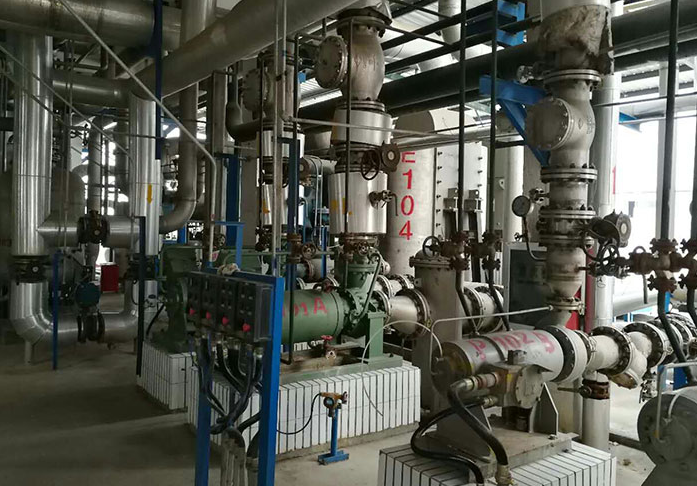Yes, hydrogen peroxide is a raw material for sodium percarbonate:
Sodium percarbonate is produced by the reaction of sodium carbonate with hydrogen peroxide, which can be done via dry, spray granulation and crystallization processes. In the dry process aqueous hydrogen peroxide solution is sprayed on solid sodium carbonate; a solid-liquid reaction yields sodium percarbonate.
What Is Sodium Percarbonate?
Sodium percarbonate, also referred to as sodium carbonate peroxide, is a solid chemical compound made by combining sodium carbonate and hydrogen peroxide. Essentially, it is a form of solid hydrogen peroxide. The combination of these two chemicals forms a highly effective cleaning agent, often included in eco-friendly household products.
Production Process of Sodium Percarbonate
1. Raw Materials: Hydrogen Peroxide and Sodium Carbonate
The two key ingredients in the production of sodium percarbonate are hydrogen peroxide (H₂O₂) and sodium carbonate (Na₂CO₃). These chemicals undergo a reaction that results in the formation of sodium percarbonate, a stable compound that slowly releases hydrogen peroxide when dissolved in water.
2. Methods of Production
There are three primary methods for producing sodium percarbonate: crystallization, spray granulation, and the dry process.
- Crystallization: This process involves combining sodium carbonate and a hydrogen peroxide solution, followed by the crystallization of sodium percarbonate.
- Spray Granulation: In this method, a hydrogen peroxide solution is sprayed onto sodium carbonate powder, and the mixture is granulated, forming sodium percarbonate particles.
- Dry Process: In this method, aqueous hydrogen peroxide is sprayed directly onto solid sodium carbonate, triggering a solid-liquid reaction that produces sodium percarbonate.
Each of these methods ensures that the hydrogen peroxide is stabilized within the sodium percarbonate structure.

Properties of Sodium Percarbonate
Sodium percarbonate is a colorless, crystalline, and hygroscopic solid that is highly soluble in water. One of its most notable properties is that it contains 32.5% hydrogen peroxide by weight. When dissolved in water, sodium percarbonate breaks down into sodium carbonate and hydrogen peroxide, releasing oxygen and acting as a bleaching agent.
Key Properties:
- Hygroscopic: Absorbs moisture from the air, making it sensitive to humidity.
- Water-Soluble: Dissolves readily in water, making it ideal for use in cleaning products.
- Oxygen-Releasing: Releases oxygen when dissolved, enhancing its cleaning and stain-removal capabilities.
Uses of Sodium Percarbonate
1. Cleaning and Laundry Products
One of the most common applications of sodium percarbonate is in laundry detergents, where it serves as a bleaching and stain-removal agent. When sodium percarbonate dissolves in water, it releases hydrogen peroxide, which helps break down organic stains and whiten fabrics. It is a popular ingredient in eco-friendly laundry detergents due to its effectiveness and safety.
2. Eco-Friendly Bleach
Sodium percarbonate is widely used in eco-friendly bleach alternatives. It provides the cleaning power of hydrogen peroxide without the harsh chemicals often found in traditional bleach products. Its ability to release oxygen makes it effective for disinfecting and deodorizing surfaces.
3. Household Cleaning Products
In addition to laundry detergents, sodium percarbonate is found in a variety of household cleaning products. Its oxygen-releasing property makes it an excellent choice for cleaning tough stains on carpets, removing mold and mildew, and even cleaning grout between tiles.
How Does Sodium Percarbonate Work?
When sodium percarbonate dissolves in water, it decomposes into sodium carbonate and hydrogen peroxide. The hydrogen peroxide, in turn, breaks down into water and oxygen. This release of oxygen is what gives sodium percarbonate its powerful cleaning and stain-removal abilities. The oxygen actively reacts with stains, particularly organic ones like grease, wine, and blood, breaking them down and lifting them away from surfaces or fabrics.
Environmental Impact
Sodium percarbonate is considered a more environmentally friendly alternative to traditional bleach products. Once dissolved, it breaks down into natural components (water, oxygen, and sodium carbonate), which do not persist in the environment or contribute to pollution. Its low toxicity and biodegradability make it a favored choice in eco-conscious cleaning formulations.
FAQs About Sodium Percarbonate
1. Is hydrogen peroxide a raw material for sodium percarbonate?
Yes, hydrogen peroxide is a key raw material used in the production of sodium percarbonate. It combines with sodium carbonate to form this versatile cleaning agent.
2. What products contain sodium percarbonate?
Sodium percarbonate is commonly found in laundry detergents, eco-friendly bleaches, household cleaners, and stain removers.
3. Is sodium percarbonate safe to use?
Yes, sodium percarbonate is generally considered safe for household use. It breaks down into water, oxygen, and sodium carbonate, all of which are non-toxic and environmentally friendly.
4. How is sodium percarbonate different from bleach?
Unlike traditional bleach, which is chlorine-based, sodium percarbonate releases oxygen when it breaks down, making it a safer and more eco-friendly alternative for stain removal and cleaning.
5. Can sodium percarbonate be used to clean outdoor surfaces?
Yes, sodium percarbonate is effective in cleaning outdoor surfaces such as decks, patios, and driveways, especially for removing stains, mold, and mildew.
6. How should sodium percarbonate be stored?
Sodium percarbonate should be stored in a cool, dry place, away from moisture and humidity, as it is hygroscopic and can absorb water from the air.
Conclusion
Sodium percarbonate is an efficient, versatile, and eco-friendly cleaning agent derived from the combination of sodium carbonate and hydrogen peroxide. Its ability to release oxygen when dissolved in water makes it a powerful cleaner for both household and industrial applications. Its environmental benefits, safety, and effectiveness in removing stains make it a popular choice in many eco-conscious cleaning products.
















